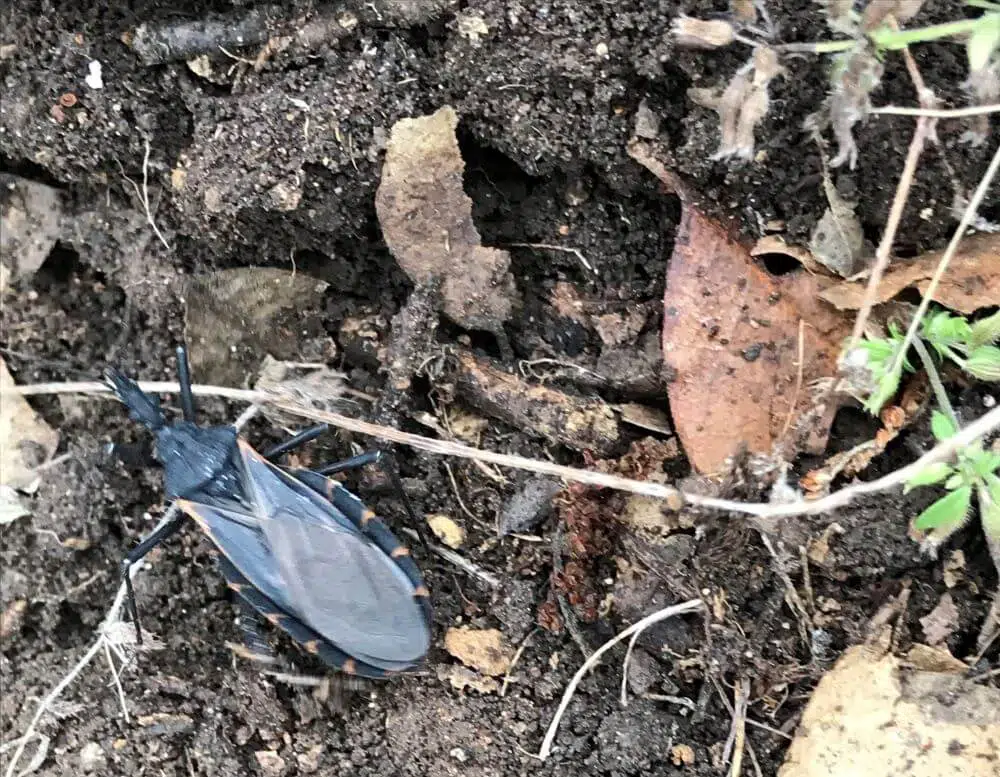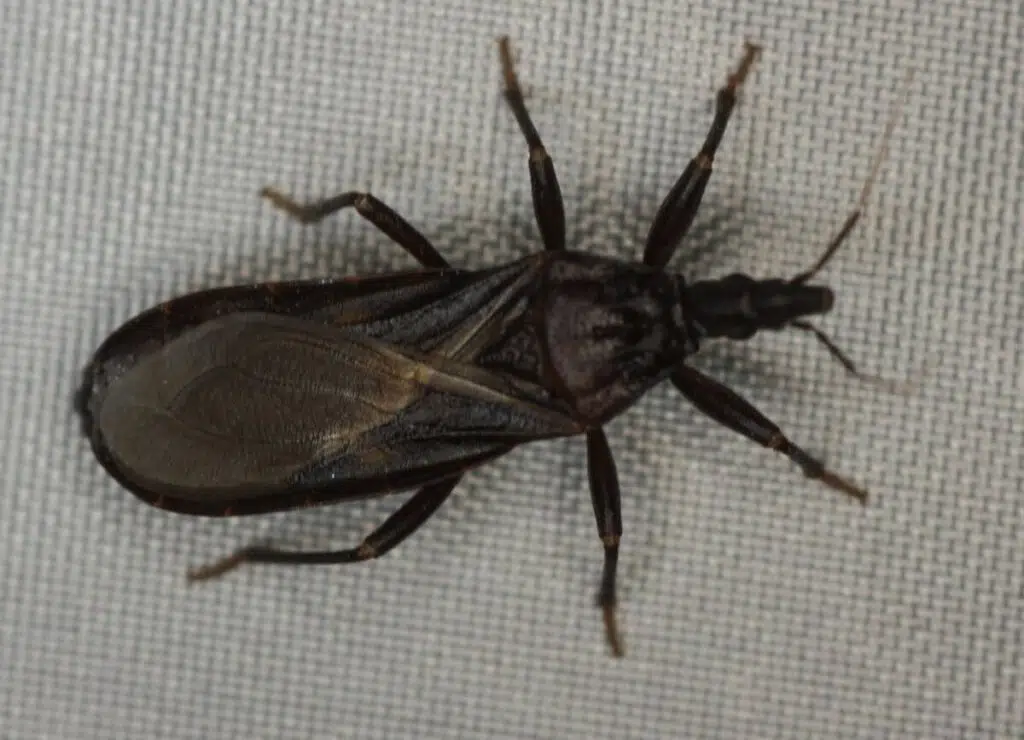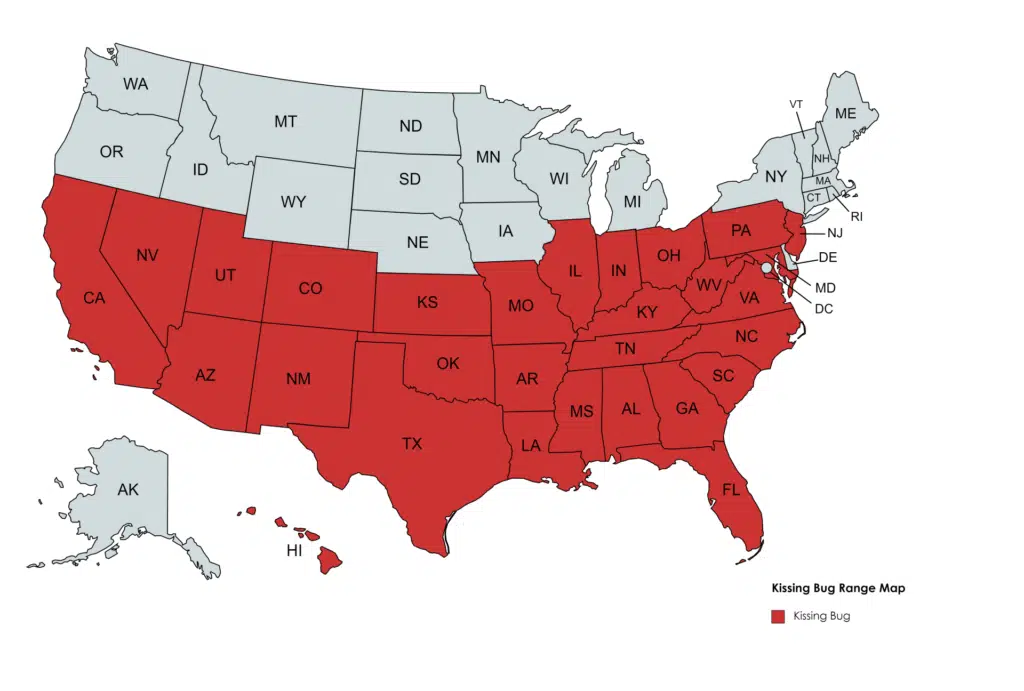Kissing bugs feed on animal and human blood similar to mosquitoes. These bugs are found in 29 US states.
These bugs are rarely truly dangerous to humans. People can apply ice packs or take over-the-counter antihistamines when they’ve suffered kissing bugs as severe reactions that require seeing a doctor are rare.
While not very common in homes, Kissing bugs can still make their way indoors in Southern states where they are found in high numbers.
These bugs mostly feed on blood from wild animals.
Table of Contents
What Are Kissing Bugs?
Part of the Triatominate family, Kissing bugs are known for feeding with blood from vertebrates.
These types of bugs have been first identified by Charles Darin in America in the 19th century. They live in most Southern US states.

Kissing Bug Identification
Kissing bugs are rarely seen during the day as they are nocturnal. These bugs prefer to hide in groups during the day.
Most Kissing bugs seen in the US are found in the proximity of domestic or wild animals.
They are attracted to human and animal breath, making their way into animal nests where they can easily drink blood from these animals.
What Do Kissing Bugs Look Like?
Kissing bugs are mostly brown or black. They might come with bright marks on the body.
They have a flat round abdomen, a conical head, and a snout-like proboscis or mouthpiece.
Typical marks are either red, orange, yellow, or a combination of these colors.
These colored marks are mostly short parallel lines that run alongside the wings.
3 most common species in the United States:
- Eastern Bloodsucking Conenose (Triatoma sanguisuga)
- Triatoma gerstaeckeri
- Western Bloodsucking Conenose (Triatoma protracta)



Behavior
Kissing bugs are nocturnal. This can be an evolutionary trait as these bugs find it easier to drink the blood of vertebrates while they sleep. Here are a few common behavioral traits of Kissing bugs.
- The bugs rest during the day and search for food at night
- Breath and body heat from animals and even humans attract Kissing bugs
- Sources of light attract Kissing bugs into the house at night
- A foul smell is released for defensive purposes
- Chagas disease is caused by Kissing bugs
- Trypanosoma cruzi is a type of parasite Kissing bugs carry in their feces
- This parasite only leads to Chagas disease when animals or people spread the feces over the bite area
- It’s common for Kissing bugs to bite humans up to 15 times around the mouth or eyes
- Kissing bug bites aren’t painful
Habitat and Distribution

Kissing bugs are found in all Southern states of the US. They are very common in Texas and Arizona.
These bugs are rarely seen outdoors, even in these states.
Preferred habitats include piles of leaves, nests of wild animals, under the porch, and in pet shelters.
Bugs That Look Like Kissing Bugs
Since these bugs can feed on human and animal blood it’s important to identify them correctly. Some bugs may also resemble Kissing bugs, but they are completely different species.
1. Flat Bugs

Flat bugs are among the most similar species to Kissing bugs.
Both species have a flattened body and around abdomen slightly narrow towards the head.
Both Flat bugs and Kissing bugs have conical-shaped heads.
Coloring is different on these species as Flat bugs exhibit a brown body with black marks that resemble tree bark.
These bugs are seen under tree bark as they resemble bark themselves. They’re also found under leaves.
If Kissing bugs are attracted to animal breath, Flat bugs are attracted to the pheromones released by Bark beetles.
These beetles are known for tree infestation. They also kill trees and vast forests across the US. Flat bugs chase these beetles, but only in trees that are already dead.
2. Leaf-footed Bugs

Leaf-footed species are known for variable body shapes. Some are oval-like Kissing bugs while others have elongated bodies.
Both oval and elongated body Leaf-footed bugs have similar coloring to Kissing bugs. They have a gray-brown color which acts as camouflage when sitting on tree bark.
Leaf-footed bugs commonly feed on tree sap and their color helps them remain undetected for potential predators.
These bugs are also attracted by squash which has led to the species being known as the Squash bug in parts of North America.
A long elongated mouthpiece also makes these bugs resemble Kissing bugs.
The long mouthpiece is used to pierce through flowers and fruits to suck juices.
Some reports have this species as a possible threat to tomato crops. However, preventive measures work for Leaf-footed bugs.
Most farmers know they need to destroy overwintering spots for these bugs. Physical removing them from crops is a fast-acting measure in case of an outbreak.
3. Scentless Plant Bugs

With a body size between 9 and 13.5mm, Scentless Plant Bugs have a high physical resemble Kissing bugs. They even share the same common habitat in states such as California and Texas.
These bugs are brown-black with red markings. They also have 3 pairs of legs as Kissing Bugs.
Young bugs of the genus are mostly red with a blackhead.
Unlike other bugs, they don’t live under tree bark but rather under trees where they feed on seeds.
Goldenrain trees are preferred by Scentless Plant Bugs.
There are multiple genera of bugs in the Rhopalidae family. Most live under trees. Some may also live on trees or on weeds.
Most of these bugs live in gardens and small orchards. There’s no evidence to suggest they can infest agricultural fields.
One of the first preventive measures to keep these bugs away is to remove all fruits they are attracted to from the ground under the trees.
The use of pesticides has also been helpful to keep the bugs away.
4. Boxelder bug

These bugs are common in North America. Part of the Hemiptera (True bug) genus, the species is mostly seen on trees such as maple, ash trees, and boxelder trees.
Boxelder bugs (Boisea trivittata) have a flattened body similar to Kissing bugs. They grow to 12.7mm and they are also known for a rounded elongated body.
The head of both species is elongated.
Boxelder bugs are known for black and orange coloring.
These bugs are routinely seen in spring and summer. It’s common to see these bugs on trees in the sun.
They start seeking indoor shelter in the fall as temperatures start to drop.
Bugs of the genus are commonly seen sitting in direct sunlight on homes and other man-made structures in the fall.
Natural habitats are also common for Boxelder bugs and Kissing bugs.
Boxelder bugs are native to the Southwestern United States.
5. Seed Bugs

Lygaeidae Seed Bugs are known for the multiple veins on their wings, similar to Kissing bugs. They are black with orange-brown marks.
Both Lygaeidae Seed Bugs and Kissing Bugs are known for having 3 pairs of legs and long antennae.
Rhyparochromidae bugs are brown or mottled. They also have 3 pairs of legs and an elongated body that resembles the elongated body of Kissing bugs.
Both Lygaeidae and Rhyparochromidae primarily feed on seeds.
6. Chinch Bugs

Chinch Bugs are native to North America. They have different coloring.
These bugs are either red or brown as they emerge. They turn black as adults. Both color variations come with white wings.
Chinch Bugs also have a bright band around the abdomen.
These bugs have a flattened body similar to the body of Kissing bugs. Their almost black body as adults resembles the dark-colored body of Kissing bugs.
Another reason why these bugs are confused with Kissing bugs is their habit of living in groups. Both Chinch Bugs and Kissing Bugs live together in small groups in warm places.
Chinch Bugs prefer warm and dry places such as sidewalks where they examine grass.
Commonly found around lawns, these bugs are considered pests as they destroy grass around the house.
Chinch Bugs are known for sucking juices out of grass and even for inserting toxins into the grass which eventually kills it.
These bugs are very resilient to insecticides which makes them hard to remove from lawns and backyards.
7. Stink Bugs

There are various types of Stink Bugs that can be differentiated by coloring. All of them are also known as Shield bugs.
They get this name from their physical shape that resembles a shield.
These bugs come in various colors from green to brown.
Stink bugs mostly resemble Kissing bugs through their long mouthparts used to drink juices from flowers and fruits.
Native to North America, Stink bugs have a different diet from the blood consumed by Kissing bugs.
Stink bugs mostly eat plants and even cause discoloration in the leaves and flowers they consume.
These bugs are also known predators eating other smaller insects.
8. Bordered Plant Bugs

Contrasting coloring on the edges of this bug makes some people confuse it with Kissing Bugs.
Both Bordered Plant Bugs and Kissing Bugs have brighter coloring on the edges on the back which makes them stand out when resting on leaves or tree bark.
Growing to a size of up to 55mm, these bugs are typically dark green or dark brown with orange marks on the edges.
Bordered Plant Bugs are stout-bodied, flattened, and rounded on the abdomen similar to Kissing Bugs.
These bugs are mostly seen in bushes but they can occasionally be seen around trees where they seek fruits and fruit juices.
9. Assassin Bugs

Assassin Bugs grow up to 40mm. These bugs have a beak between the front legs used to pierce prey and suck the liquids of insects which make them resemble Kissing bugs.
Most species of Assassin Bugs are either brown or black looking similar to dark-colored Kissing bugs.
Most Assassin bugs resemble Kissing bugs in habits as well.
These bugs also live outdoors. They can suck the blood of vertebrates, including the blood of humans, similarly to Kissing bugs.
There are over 130 species of Reduviidae family bugs in North America. They can be distinguished from regular Kissing bugs by the pain inflicted with each bite.
Kissing bugs are normally not known for painful bites. Many people don’t realize they’ve been bitten by these bugs.
Reduviidae bugs have painful bites in turn. These bites often lead to local swelling.
10. Damsel Bugs

Damsel Bugs have a pear-shaped body resembling Kissing bugs.
The species is known for its tan color and 3 pairs of legs. Its front legs are used to catch and hold prey as these bugs are predators in agricultural fields.
Apart from having a pear-shaped body, Damsel Bugs also have a flattened body similar to Kissing bugs.
Common in North America, these bugs eat aphids, moths, various larvae, caterpillars, potato beetles, and other small insects.
11. Plant Bugs

Also known as Leaf bugs, Plant bugs are part of the Heteroptera genus in the Miridae family.
The species is known for an oval-shaped body with an elongated form of up to 12mm that resembles the shape of Kissing bugs.
Plant bugs can be differentiated from Kissing bugs by coloring.
They have a patterned body that distinguishes white, brown, black, and yellow colors, unlike the mostly dark-colored Kissing bugs.
Further differences between the species can be seen with antennae. Plant bugs have 4-segments antennae while Kissing bugs have 6-segments antennae.
The shape of the head also helps distinguish the species from Kissing bugs as Plant bugs have a round-shaped head.
Still, both Plant bugs and Kissing bugs share the same habitats in certain regions of the world. Over 2.000 species of Plant bugs live in North America.
These species only intersect with Kissing bugs in areas with rich agricultural fields which may also attract animals Kissing bugs are interested in.
Summary
Kissing bugs are feared for their ability to drink blood. They can also spread diseases such as Chagas disease.
The flattened pear-shaped body of Kissing bugs is seen in a wide range of other species which often leads to confusion. Kissing bugs have a few visible distinct traits that help differentiate the species from other similar ones. Yellow, red, or tan markings on its edges are mostly characteristic of this species.
Further Reading: